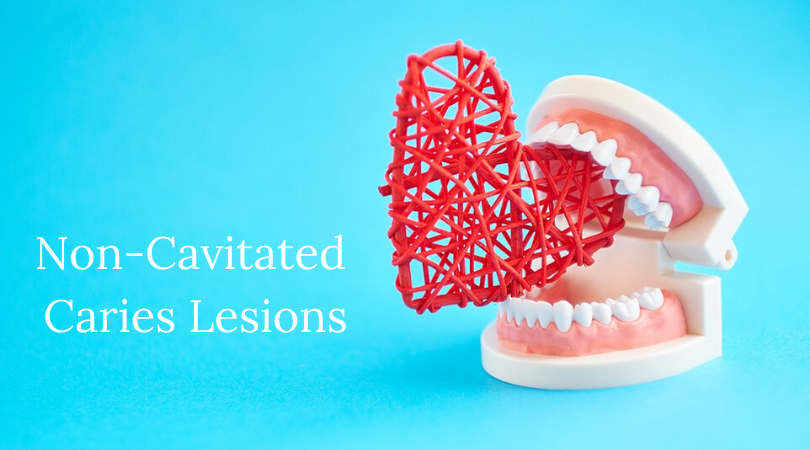Non-Cavitated Caries Lesions
The most common cause of cavitated dental lesions is caries. According to caries definition, it is a tooth decay caused by bacterial effect. However, there are other diseases that result in the development of defects in enamel and dentin. They can be congenital and acquired caused by external and internal (genetic, etc.) factors. Non-carious lesions of the teeth (in contrast to caries) usually occur in areas of teeth that are not susceptible to caries – tubercles, anterior surface (visible with a smile), the entire tooth, etc. They are characterized by a change in color (brown spot lesions), the presence of a tissue defect, sometimes an unusual shape of the teeth, etc.
 Non-carious (non-microbial) lesions of the teeth can be caused by the following diseases:
Non-carious (non-microbial) lesions of the teeth can be caused by the following diseases:
- Fluorosis. It is a chronic disease resulting from excess fluoride intake. Excess fluorine leads to uneven mineralization, increased brittleness, enamel hypoplasia, and the appearance of defects in it. It incipiently occurs when water is mineralized with fluorine in excess of 1.5 mg/L. This disease is characterized by white and yellowish spots, sometimes erosion on teeth, while other human bones also suffer. Fluorosis often occurs in children living in regions with high levels of fluoride in water, air, and soil. Treatment should include the normalization of fluoride content, remineralizing therapy. Sometimes enamel defect treatment is used.
- Enamel hypoplasia. Enamel hypoplasia, or insufficient, impaired mineralization, occurs in 6-9% of children. Its characteristic manifestations are white spots, erosion, and grooves on the front teeth surfaces. All of them are located symmetrically on the right and left halves of the dentition. Violation of mineralization, as a rule, is not accompanied by pain or other sensations. The main cause of hypoplasia is considered to be common diseases of the child that occurred in the 1-2 years of life – rickets, diarrhea, colds, metabolic disorders, severe infant infections, etc. Treatment of the spotted form is limited to remineralizing therapy for 6-12 months. After a month-long course of remineralizing therapy, the erosive and furrowed forms are treated with glass ionomer cement – special materials that give calcium and fluoride within 10-20 months to tooth tissues. Other filling materials are not recommended.
- Erosion of hard tooth tissues. Erosion of hard tissues of the tooth – a decrease in enamel and dentin – arises from excessive enthusiasm for acid juices, from the habit of lemon or other fruits rich in acid. In recent years, erosion is often found in infants, to whom parents give large quantities of apple, orange juice. Their acidity is significant. A constant effect on the teeth results in their demineralization. That’s why mothers should not give babies at night, so that they soon fall asleep, sour juices or water acidified with lemon. This is harmful because, during sleep, salivation, and its ability to neutralize acid are markedly reduced. Erosions usually occur on the front group of teeth, primarily on fangs, small molars, and incisors, first in the form of subtle clouding of enamel, loss of gloss on a small area of the front surface of the tooth, which indicates a violation of mineralization, and two symmetrical teeth are affected. Erosions have a slightly concave round, oval or irregular shape. Patients complain of an increased sensitivity of the teeth to any stimuli: temperature (pain, pain can cause a sip of cold water), mechanical (the pain appears even from the touch of a toothbrush). Erosions caused by diseases of the gastrointestinal tract arise under the influence of acid.
- Wedge-shaped defect. A wedge-shaped defect, a progressive decrease in tooth hard tissues, is a characteristic lesion of a tooth in the area of its neck and has the wedge shape. It develops after teething of permanent teeth, most often after 25-30 years on a background of general body diseases. It counts about 12-16% of non-carious lesions of permanent teeth. It can also occur under the influence of mechanical factors. Numerous cases of abrasion of the vestibular (anterior) surface of the teeth are known in those who use hard toothbrushes and very often change them.
- Increased tooth abrasion. Increased abrasion of the chewing surface and the cutting edges of the teeth may be due to hard food. This non-carious tooth lesion occurs in 10-12% of adults and is associated with general body disorders, mainly with endocrine disorders. Therefore, the patient must undergo a comprehensive examination by a dentist and other specialists in order to then properly treat the background disease and eliminate the unfavorable situation in the oral cavity. Increased abrasion and, as a consequence, malocclusion can cause poor manufacturing and poor fitting of dentures.
Category: Health and Wellness